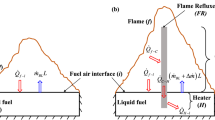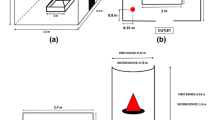Abstract
The objective of this work is to provide a ‘support tool’ to assess the burning rate of a pool fire in a well-confined and mechanically-ventilated room using a single-zone model based on conservation equations for mass, energy and oxygen concentration. Such configurations are particularly relevant for nuclear facilities where compartments are generally sealed from one another and connected through a ventilation network. The burning rates are substantially affected by the dynamic interaction between the fuel mass loss rate and the rate of air supplied by mechanical ventilation. The fuel mass loss rate is controlled by (i) the amount of oxygen available in the room (i.e. vitiation oxygen effect) and (ii) the thermal enhancement via radiative feedback from the hot gas to the fuel surface. The steady-state burning rate is determined by the ‘interplay’ and balance between the limiting effect of oxygen vitiation and the enhancing effect of radiative feedback. An extensive sensitivity study over a wide range of fuel areas and mechanical ventilation rates shows that a maximum burning rate may be obtained. For the studied HTP (Hydrogenated Tetra-Propylene) pool fires, the maximum burning rate is up to 1.75 times the burning rate in open air conditions.













Similar content being viewed by others
Abbreviations
- A :
-
Area (m2)
- c p :
-
Specific heat (kJ/kg K)
- F :
-
Configuration factor (−)
- H :
-
Height (m)
- h c :
-
Convective heat transfer coefficient (kW/m2 K)
- h k :
-
Conduction heat transfer coefficient (kW/m K)
- k :
-
Conductivity (kW/m K)
- L v :
-
Heat of vaporization of the fuel (kJ/kg)
- \( \dot{m} \) :
-
Mass flow rate (kg/s)
- P :
-
Room pressure (Pa)
- \( \dot{Q}_{f} \) :
-
Heat release rate of fire (kW)
- \( \dot{q}^{''}_{R} \) :
-
Radiative heat flux (kW/m2)
- T :
-
Temperature (K)
- TR :
-
Renewal rate (h−1)
- t :
-
Time (s)
- V :
-
Room volume (m3)
- \( \dot{V} \) :
-
Volume flow rate (m3/s)
- \( Y_{{O_{2} }} \) :
-
Oxygen mass fraction (kg/kg)
- ΔH c :
-
Heat of combustion of fuel (kW/kg)
- \( \Delta H_{{{\text{O}}_{2} }} \) :
-
Heat of combustion per unit mass of oxygen (kW/kg)
- Δp :
-
Pressure difference (Pa)
- Δpmax :
-
Stall pressure of the fan (Pa)
- γ :
-
Isentropic coefficient of gas (−)
- ε :
-
Gas emissivity (-)
- ρ :
-
Gas density (kg/m3)
- σ :
-
Stephan–Boltzmann constant (= 5.67 × 10−11 kW/m2 K4)
- χ :
-
Combustion efficiency (−)
- ″:
-
Rate per unit area
- a :
-
Ambient conditions
- b :
-
Burning
- ex :
-
Extraction
- F :
-
Fuel
- in :
-
Inlet
- op :
-
Opening
- open :
-
Open conditions
- v :
-
Vaporization
- w :
-
Walls (+ceiling and floor)
- 0:
-
Initial condition
- ∞:
-
Limiting rate
References
Bullen ML, Thomas PH (1979) Compartment fires with non-cellulosic fuels. Proc Combust Inst 17:1139–1148. doi:10.1016/S0082-0784(79)80108-3
Takeda H, Akita K (1981) Critical Phenomenon in Compartment Fires With Liquid Fuels. Proc Combust Inst 18:519–527. doi:10.1016/S0082-0784(81)80057-4
Bishop SR, Holborn PG, Beard AN, Drysdale DD (1993) Nonlinear dynamics of flashover in compartment fires. Fire Saf J 21:11–45. doi: 10.1016/0379-7112(93)90003-9
Holborn PG, Bishop SR, Drysdale DD, Beard AN (1993) Experimental and theoretical models of flashover. Fire Saf J 21:257–266. doi: 10.1016/0379-7112(93)90030-T
Peatross MJ, Beyler CL (1997) Ventilation effects on compartment fire characterization. Fire Saf Sci. doi:10.3801/IAFSS.FSS.5-403
Delichatsios MA, Silcock GWH (2003) Fully involved enclosure fires: effects of fuel type, fuel area and geometry. Fire Saf Sci. doi:10.3801/IAFSS.FSS.7-59
Utiskul Y, Quintiere JG, Rangwala AS, Ringwelski BA, Wakatsuki K, Naruse T (2005) Compartment fire phenomena under limited ventilation. Fire Saf J 40:367–390. doi: 10.1016/j.firesaf.2005.02.002
Kawagoe K (1958) Fire behaviour in rooms. Report No. 27. Building Research Institute, Tokyo
Thomas PH, Heselden AJM, Law M (1967). Fully developed compartment fires: two kinds of behaviour. Fire Research Technical Paper No. 18. HMSO, London
Nishio G, Machida S, (1987) Pool fires under atmosphere and ventilation in steady-state burning, Part II. Fire Technol 23:186–197. doi: 10.1007/BF01036935
McCaffrey BJ, Quintiere JG, Harkleroad MF (1981) Estimating room temperatures and the likelihood of flashover using fire test data correlations. Fire Technol 17:98–119. doi: 10.1007/BF02479583
Foote KL, Pagni PJ, Alvares NJ (1985) Temperature correlations for forced-ventilated compartment fires. Fire Saf Sci. doi: 10.3801/IAFSS.FSS.1-139
Prétrel H, Querre P, Forestier M (2005) Experimental study of burning rate behaviour in confined and ventilated fire compartments. Fire Saf Sci. doi: 10.3801/IAFSS.FSS.8-1217
Melis S, Audouin L (2008) Effects of vitiation on the heat release Rate in mechanically-ventilated compartment fires. Fire Saf Sci. doi: 10.3801/IAFSS.FSS.9-931
Audouin L et al. (2011) Quantifying differences between computational results and measurements in the case of a large-scale well-confined fire scenario. Nucl Eng Des 241:18–31. doi: 10.1016/j.nucengdes.2010.10.027
Bonte F, Noterman N, Merci B (2013) Computer simulations to study interaction between burning rates and pressure variations in confined enclosure fires. Fire Saf J 26:125–143. doi: 10.1016/j.firesaf.2013.01.030
Pelzer M, Klein-Heβling W (2013) Validation of COCOSYS pyrolysis models on OECD PRISME fire experiments. Fire Saf J 62:174–191. doi: 10.1016/j.firesaf.2013.01.016
Quintiere JG (2006) Fundamentals of fire phenomena. Wiley, West Sussex, England
Stern-Gottfried J, Rein G, Bisby LA, Torero JL (2010) Experimental review of the homogeneous temperature assumption in post-flashover compartment fires. Fire Saf J 45:249–261. doi: 10.1016/j.firesaf.2010.03.007
Santo G., Tamanini F (1981) Influence of oxygen concentration on the radiative properties of PMMA. Proc Combust Inst 18:619–631. doi: 10.1016/S0082-0784(81)80067-7
Babrauskas V (1983) Estimating large pool fire burning rates. Fire Technol 19:251–261
Acknowledgments
The research activities as described in this paper were funded by Bel V through a post-doctoral research grant (Contract Number A12/TT/0617).
Author information
Authors and Affiliations
Corresponding author
Rights and permissions
About this article
Cite this article
Beji, T., Merci, B. Assessment of the Burning Rate of Liquid Fuels in Confined and Mechanically-Ventilated Compartments using a Well-Stirred Reactor Approach. Fire Technol 52, 469–488 (2016). https://doi.org/10.1007/s10694-014-0418-1
Received:
Accepted:
Published:
Issue Date:
DOI: https://doi.org/10.1007/s10694-014-0418-1




